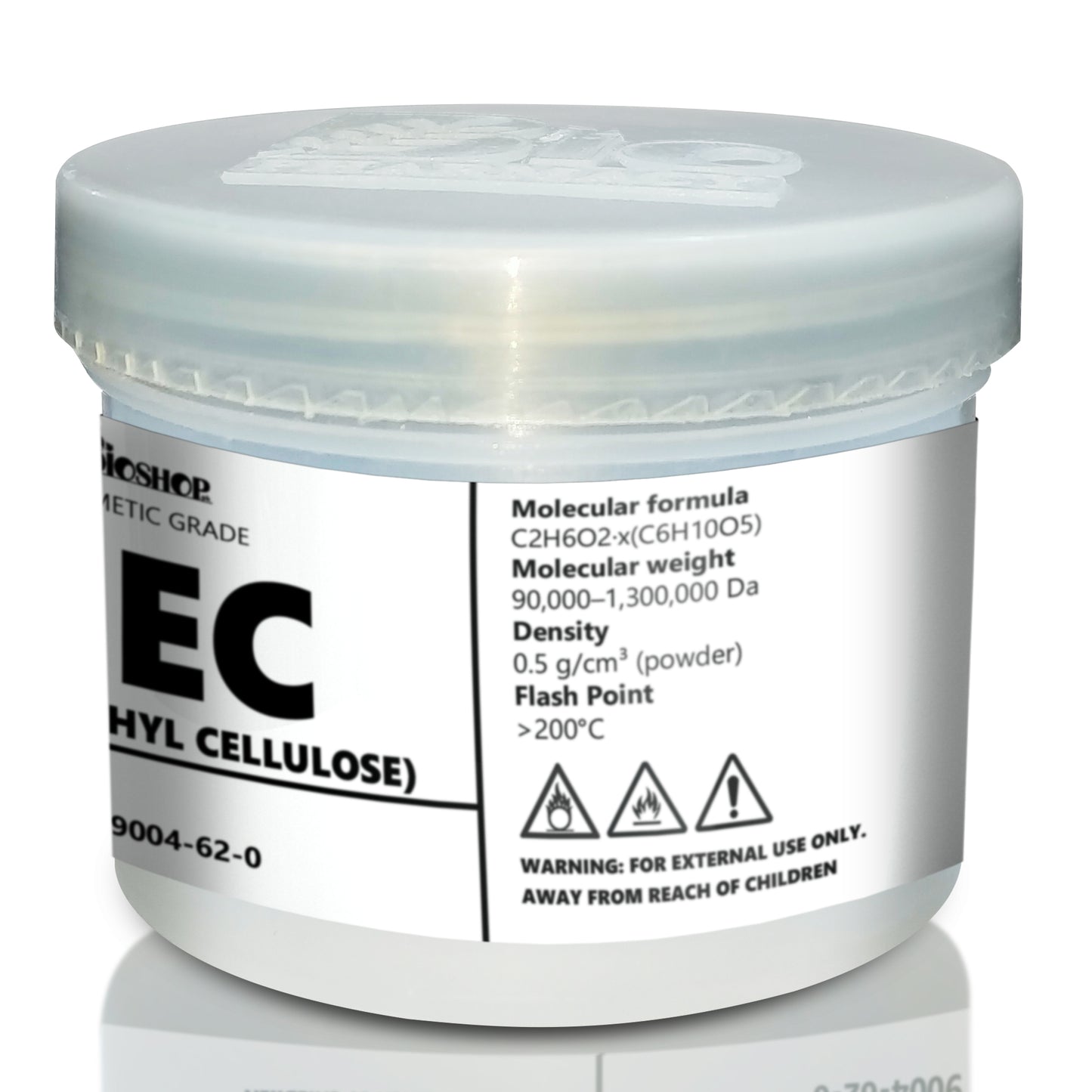Bio Shop
Hydroxyethyl Cellulose (HEC)
Hydroxyethyl Cellulose (HEC)
Key Functions: Works as a natural thickening agent and stabilizer, forming clear gels and improving product texture and flow.
Couldn't load pickup availability
Explore
Information About Hydroxyethyl Cellulose (HEC)
✅ Key Features
- Non-ionic, water-soluble thickener from cellulose
- Forms crystal-clear gels and suspensions
- Improves texture, glide, and stability in formulations
- Compatible with surfactants, actives, and electrolytes
- Ideal for serums, shampoos, masks, and water-based gels
🔬 Description
Hydroxyethyl Cellulose (HEC) – Natural Thickener & Film Former
Hydroxyethyl Cellulose (HEC) is a natural-derived, non-ionic polymer used as a thickener, rheology modifier, film-former, and suspending agent in a wide variety of cosmetic and personal care products. It hydrates in water to form crystal-clear gels and improves spread ability, stability, and feel of creams, serums, shampoos, and masks. HEC is gentle and suitable for sensitive skin, making it an excellent choice for clean beauty and sulfate-free formulations.
📊 Technical Data
INCI Name: Hydroxyethyl Cellulose
CAS Number: 9004-62-0
Solubility: Water-soluble
Add Phase: Water phase (pre-dispersed, then hydrated)
pH Stability: 3.0 – 9.0
Processing Temperature: Below 75°C
Appearance: White to off-white powder
Odor: Odorless
Molecular Formula: C2H6O2·(C6H10O5)n
Molecular Weight: Variable (polymeric)
Flash Point: Non-flammable
Density: ~0.5 g/cm³
Chemical Type: Cellulose ether polymer
Functional Groups: Hydroxyethyl, hydroxyl groups
Primary Cosmetic Uses: Thickening, stabilizing, suspending, film-forming
🧪 Recommended Usage
- Usage Rate: 0.5% – 2.5%
- Phase: Add to water phase; allow hydration before stirring
- Ideal For: Clear Serums, Shampoos, Cleansers, Creams, Face Masks
💡 Pro Tip
🌊 To avoid clumping, pre-wet HEC in glycerin or a glycol before adding to water. Let it hydrate undisturbed for 20–30 minutes, then mix slowly. Use a high-shear mixer for fast gel clarity and viscosity.
👩🔬 Skin Type Compatibility
✔️ Non-irritating and safe for all skin types
✔️ Excellent for sensitive, oily, acne-prone, or baby skin formulations
🧴 Formulation Ideas
1. Clear Hydrating Serum Base
Use 1% HEC with glycerin and panthenol to form a silky, transparent serum gel.
2. Sulfate-Free Shampoo
Combine with mild surfactants and polyquaternium-10 for rich, stable foam and reduced irritation.
3. Face Mask Gel Base
Use 1.5% with aloe vera, niacinamide, or clay suspensions to create soothing or detox masks.
4. Light Cream Emulsion
Stabilize O/W emulsions with 0.5% HEC to improve texture and prevent separation.
5. Micellar Water Gel
Thicken micellar water with 0.3–0.5% HEC for improved application and mild cleansing.
💧 Cosmetic Suitability:
Serums
⭐⭐⭐⭐⭐ – Excellent
🟩🟩🟩🟩🟩 – Ideal for transparent gel formulations.
Creams & Lotions
⭐⭐⭐⭐☆ – Good
🟩🟩🟩🟩⬜ – Improves viscosity and stability.
Toners
⭐⭐⭐☆☆ – Moderate
🟧🟧🟧⬜⬜ – Can create toner-gels or hydrating waters.
Face Masks
⭐⭐⭐⭐☆ – Good
🟩🟩🟩🟩⬜ – Suspends clays, powders, and botanicals.
Cleansers
⭐⭐⭐⭐☆ – Good
🟩🟩🟩🟩⬜ – Adds slip, stability, and softness.
Hair Masks
⭐⭐⭐⭐☆ – Good
🟩🟩🟩🟩⬜ – Enhances application and feel.
Deodorants
⭐⭐☆☆☆ – Fair
🟧🟧⬜⬜⬜ – Can be used in gel-based roll-ons.
Eye Creams
⭐⭐⭐⭐☆ – Good
🟩🟩🟩🟩⬜ – Suitable for lightweight gel textures.
Shampoos
⭐⭐⭐⭐⭐ – Excellent
🟩🟩🟩🟩🟩 – Improves thickness and foam stability.
Soaps
⭐☆☆☆☆ – Poor
🟥⬜⬜⬜⬜ – Not typically used in bar soap formulations.
Conditioners
⭐⭐⭐⭐☆ – Good
🟩🟩🟩🟩⬜ – Improves creaminess and spreadability.
Lip Balms
☆☆☆☆☆ – Not Suitable
🟥⬜⬜⬜⬜ – Not compatible with oil-based lip care.
Body Butters
⭐⭐☆☆☆ – Fair
🟧🟧⬜⬜⬜ – May improve water-phase viscosity.
Ointments
⭐⭐☆☆☆ – Fair
🟧🟧⬜⬜⬜ – Use in gel ointments or medicated carriers.
❓ FAQs
Q1: Can I use HEC in clear gels?
A1: Yes! HEC creates crystal-clear gels perfect for serums and tonics.
Q2: Is HEC suitable for natural/clean beauty products?
A2: Absolutely. It’s derived from cellulose and widely accepted in clean formulations.
Q3: Can it be used in hot processing?
A3: Hydrate below 75°C. Avoid overheating to preserve viscosity.
Q4: Will HEC affect pH or actives?
A4: It’s non-ionic and compatible with acids, bases, and electrolytes.
Q5: Is HEC sticky or heavy?
A5: No — it leaves a smooth, light finish when used at correct levels.
📂 Documentation
Upon request, we will provide.
Where Can You Safely Use Hydroxyethyl Cellulose (HEC)
Discover how Hydroxyethyl Cellulose (HEC) performs across different products — rated for safety, stability, and effectiveness.







